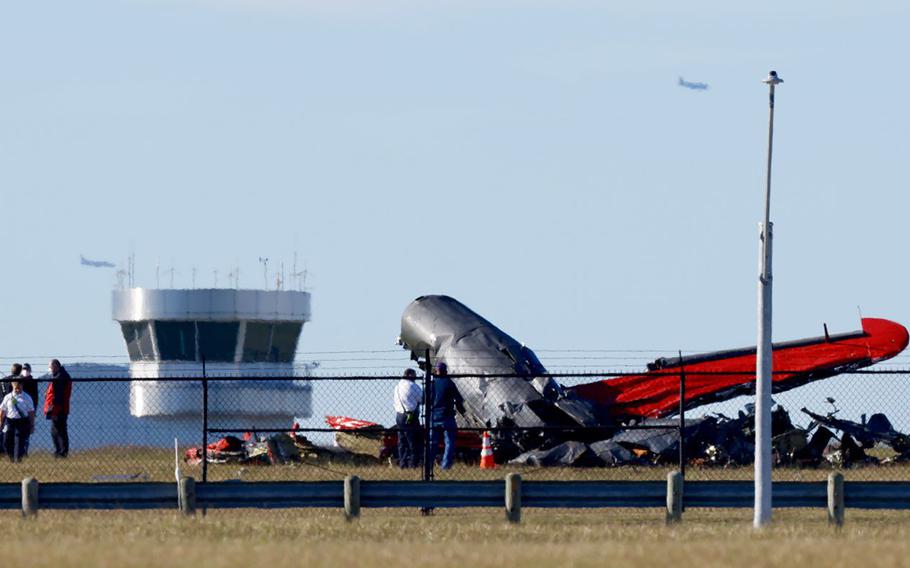U.S.
Feds release nearly 2,000 pages of new information related to deadly Dallas air show crash
The Dallas Morning News March 11, 2024

Damage from a mid-air collision between two planes sits within the fence line of the Dallas Executive Airport on Nov. 12, 2022. (Liesbeth Powers, The Dallas Morning News/TNS)
DALLAS — The National Transportation Safety Board published Monday an in-depth look into the 2022 Dallas air show crash that killed six people.
The public docket consists of nearly 2,000 pages of new information, including interview transcripts, photos, medical and toxicology reports, maintenance records and laboratory examinations. It is not a final report and does not declare a cause for the crash.
On Nov. 12, 2022, two World War II-era planes, a Boeing B-17 Flying Fortress and a Bell P-63 Kingcobra, collided at Dallas Executive Airport during the Wings Over Dallas show. One pilot was in the P-63 while two pilots and three crew members were in the B-17.
The Commemorative Air Force, which hosted the Wings Over Dallas show in 2022, identified those who died as Terry Barker, Craig Hutain, Kevin Michels, Dan Ragan, Len Root and Curt Rowe. No one on the ground was injured or killed.
A short, preliminary investigative report was released less than three weeks after the crash, and officials have said the final report was expected to take 12 to 18 months. NTSB did not provide an updated timeline Monday, but said the final report will include analysis, findings, recommendations and probable cause determinations.
P-63’s GPS system inactive since 2014
Skies were clear when both airplanes departed at 1 p.m. No wind gusts were present and no turbulence was reported, officials said.
The Bell P-63 Kingcobra was registered under the American Airpower Flying Museum. It sat one and had one engine.
Craig Hutain, 63, of Montgomery, was flying in the single-seat plane and wearing a four-point restraint.
Pilots are required by the Federal Aviation Administration to be cleared for medical purposes, both physically and mentally. Hutain’s last medical certificate was Nov. 1, 2022, and he had no limitations.
Hutain’s death was ruled accidental from blunt force injuries, according to an autopsy summary. His autopsy was limited by the severity of his injuries.
A Garmin GPSMAP 496 was recovered from the crash, according to a report from the electronic recorder devices specialist.
It is a battery-powered 12-channel GPS receiver that receives satellite radio for flight information, the report said. A track log of latitude, longitude, date, time and GPS altitude information are stored. If the device’s memory becomes full, new information would overwrite the oldest information or recording would stop, depending on how it was configured.
Although the Garmin GPSMAP 496 was damaged, a memory chip was removed from the circuit board. The chip recovered 47 recordings from July 30, 2013, to June 19, 2014 — and none from Nov. 12, 2022.
No track logs were shown in Texas, confirming the crash was never recorded.
“It is likely that the device’s track log recording function had been inactive since 2014,” the report read.
A transcript was released with communications from the aircraft involved in the incident.
After the crash, a person instructing the show repeatedly said “knock it off” and “roll the trucks” to the other aircraft over the radio.
The other planes diverted to alternative airports following the incident.
Passengers and pilots aboard B-17
The Boeing B-17 Flying Fortress, a four-engine aircraft, was also registered to the American Airpower Heritage Flying Museum. It had 10 seats — four for crew members and six for passengers.
Len Root, 66, of Fort Worth, was flying the plane in the captain’s seat.
Root wore glasses for near vision but had received his last medical certificate in September 2022. Root had all of his required flying certificates.
Root’s family filed a lawsuit last year against the Commemorative Air Force, the American Airpower Heritage Flying Museum Inc. and the American Airpower Heritage Museum Inc. Root’s wife and daughters said the suit was filed “to help ensure safety for pilots participating in air shows and to show that the tragic death of a beloved husband and father is an immense loss made even more traumatic by its preventable nature,” according to the law firm representing the family.
To Root’s right was Terry Barker, 67, of Keller, who wore corrective lenses and had glasses on hand for his vision. His last medical certification was October 2022. Barker also had all of his required certificates.
Three others were aboard the Boeing aircraft: Curt Rowe, Dan Ragan and Kevin Michels. Rowe wore a lap restraint, according to the National Transportation Safety Board. It is unclear whether Ragan and Michels had restraints.
All of the passengers’ deaths aboard the B-17 were ruled accidental from blunt force injuries, according to autopsy summaries. All of the autopsies were limited because of the severity of the men’s injuries.
The planes crashed at about 500 feet in the air, and the National Transportation Safety Board reported the Boeing aircraft caught fire both on the ground and in-flight and exploded. Officials said both planes were “totally destroyed.”
Recovered from the Boeing plane was an Avidyne IFD540 flight management system, GPS and navigator. The device could monitor and record navigational information. It was damaged in the fire but appeared to be in “good condition,” the report said. Officials inserted its compact flash card, which stores flight data, into another device to view data.
It recovered five sessions from Nov. 6 to Nov. 12, and recorded the incident on Nov. 12. The flight was 13 minutes and 4 seconds, according to the report.
©2024 The Dallas Morning News.
Distributed by Tribune Content Agency, LLC.